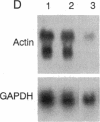Abstract
Antibodies to the acetylcholine receptor (AChR), which are diagnostic of the human autoimmune disease myasthenia gravis, block AChR function and increase the rate of AChR degradation leading to impaired neuromuscular transmission. Steroids are frequently used to alleviate symptoms of muscle fatigue and weakness in patients with myasthenia gravis because of their well-documented immunosuppressive effects. We show here that the steroid dexamethasone significantly increases total surface AChRs on cultured human muscle exposed to myasthenia gravis sera. Our results suggest that the clinical improvement observed in myasthenic patients treated with steroids is due not only to an effect on the immune system but also to a direct effect on muscle. We propose that the identification and development of pharmacologic agents that augment receptors and other proteins that are reduced by human genetic or autoimmune disease will have broad therapeutic applications.
Full text
PDF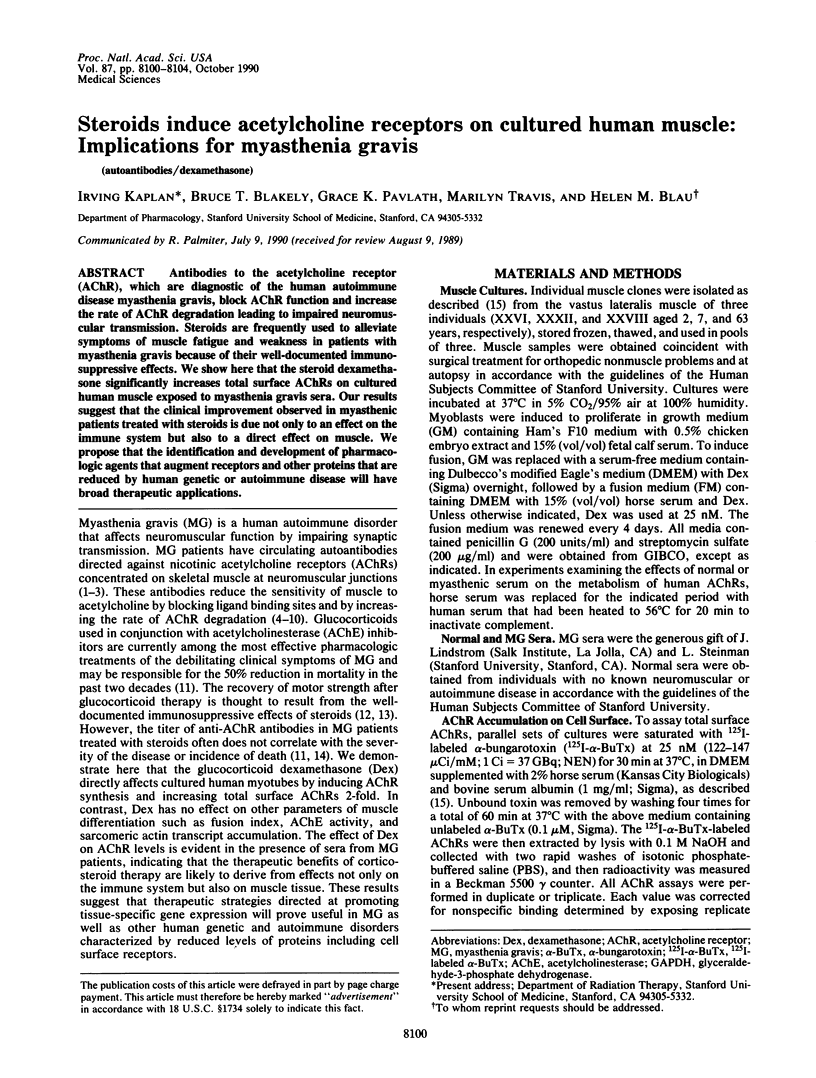
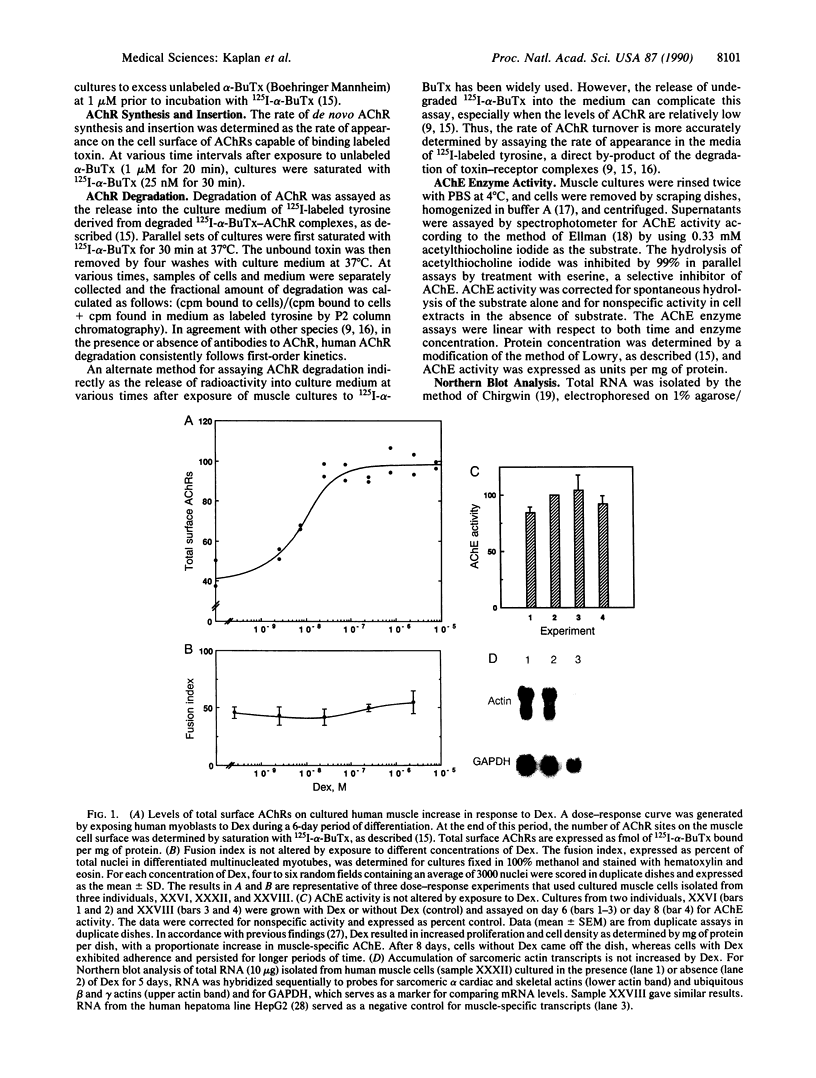
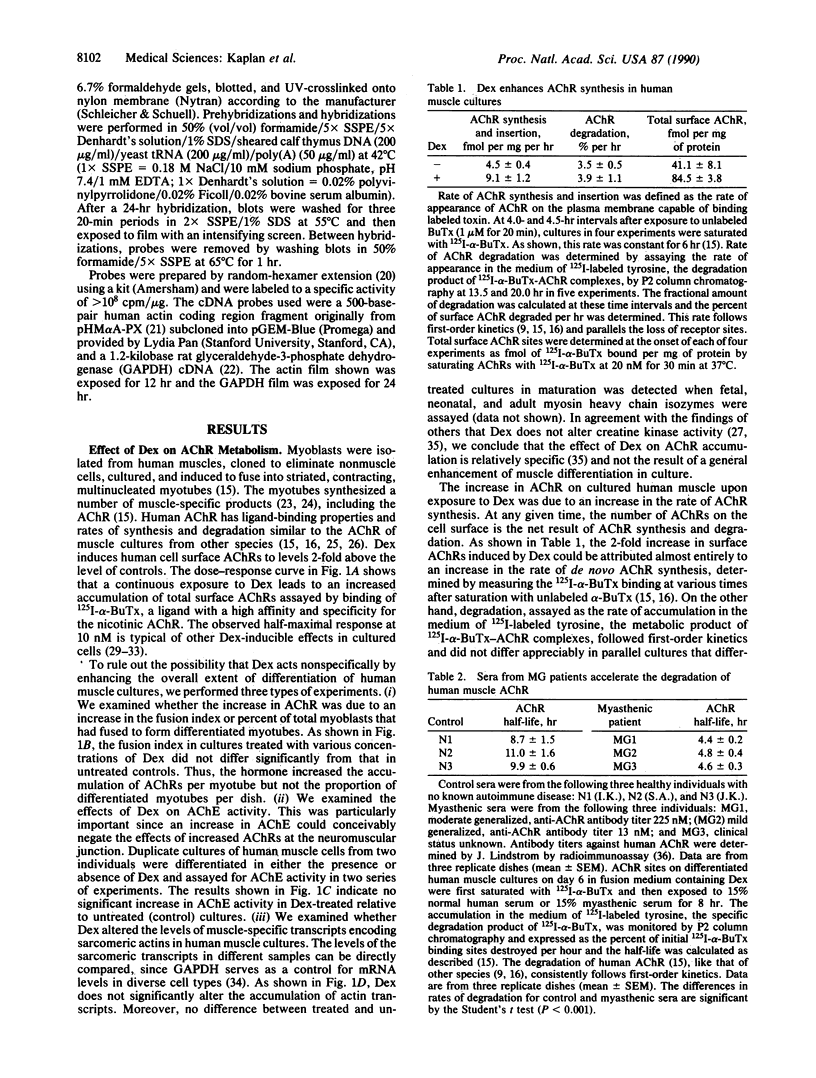

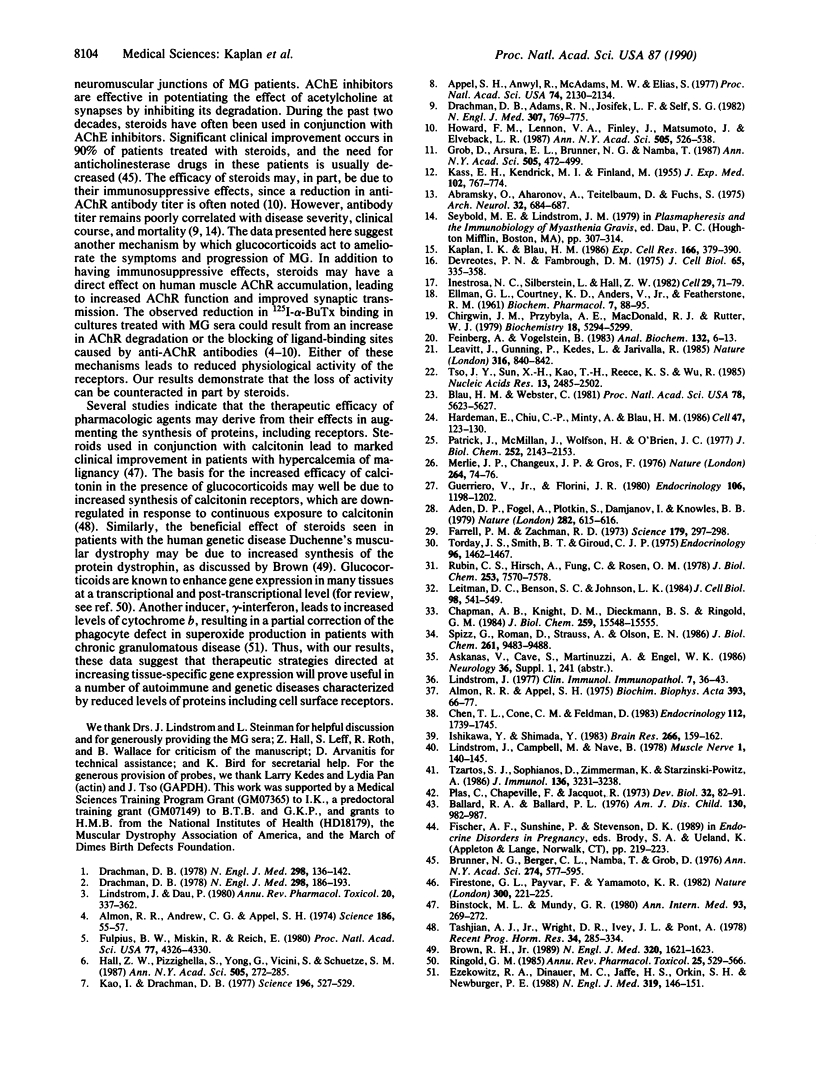
Images in this article
Selected References
These references are in PubMed. This may not be the complete list of references from this article.
- Abramsky O., Aharonov A., Teitelbaum D., Fuchs S. Myasthenia gravis and acetylcholine receptor. Effect of steroids in clinical course and cellular immune response to acetylcholine receptor. Arch Neurol. 1975 Oct;32(10):684–687. doi: 10.1001/archneur.1975.00490520054008. [DOI] [PubMed] [Google Scholar]
- Aden D. P., Fogel A., Plotkin S., Damjanov I., Knowles B. B. Controlled synthesis of HBsAg in a differentiated human liver carcinoma-derived cell line. Nature. 1979 Dec 6;282(5739):615–616. doi: 10.1038/282615a0. [DOI] [PubMed] [Google Scholar]
- Almon R. R., Andrew C. G., Appel S. H. Serum globulin in myasthenia gravis: inhibition of alpha-bungarotoxin binding to acetylcholine receptors. Science. 1974 Oct 4;186(4158):55–57. doi: 10.1126/science.186.4158.55. [DOI] [PubMed] [Google Scholar]
- Almon R. R., Appel S. H. Interaction of myasthenic serum globulin with the acetylcholine receptor. Biochim Biophys Acta. 1975 May 30;393(1):66–77. doi: 10.1016/0005-2795(75)90217-2. [DOI] [PubMed] [Google Scholar]
- Appel S. H., Anwyl R., McAdams M. W., Elias S. Accelerated degradation of acetylcholine receptor from cultured rat myotubes with myasthenia gravis sera and globulins. Proc Natl Acad Sci U S A. 1977 May;74(5):2130–2134. doi: 10.1073/pnas.74.5.2130. [DOI] [PMC free article] [PubMed] [Google Scholar]
- Ballard R. A., Ballard P. L. Use of prenatal glucocorticoid therapy to prevent respiratory distress syndrome. A supporting view. Am J Dis Child. 1976 Sep;130(9):982–987. doi: 10.1001/archpedi.1976.02120100072011. [DOI] [PubMed] [Google Scholar]
- Binstock M. L., Mundy G. R. Effect of calcitonin and glutocorticoids in combination on the hypercalcemia of malignancy. Ann Intern Med. 1980 Aug;93(2):269–272. doi: 10.7326/0003-4819-93-2-269. [DOI] [PubMed] [Google Scholar]
- Blau H. M., Webster C. Isolation and characterization of human muscle cells. Proc Natl Acad Sci U S A. 1981 Sep;78(9):5623–5627. doi: 10.1073/pnas.78.9.5623. [DOI] [PMC free article] [PubMed] [Google Scholar]
- Brown R. H., Jr Prednisone therapy for Duchenne's muscular dystrophy. N Engl J Med. 1989 Jun 15;320(24):1621–1623. doi: 10.1056/NEJM198906153202410. [DOI] [PubMed] [Google Scholar]
- Brunner N. G., Berger C. L., Namba T., Grob D. Corticotropin and corticosteroids in generalized myasthenia gravis: comparative studies and role in management. Ann N Y Acad Sci. 1976;274:577–595. doi: 10.1111/j.1749-6632.1976.tb47717.x. [DOI] [PubMed] [Google Scholar]
- Chapman A. B., Knight D. M., Dieckmann B. S., Ringold G. M. Analysis of gene expression during differentiation of adipogenic cells in culture and hormonal control of the developmental program. J Biol Chem. 1984 Dec 25;259(24):15548–15555. [PubMed] [Google Scholar]
- Chen T. L., Cone C. M., Feldman D. Glucocorticoid modulation of cell proliferation in cultured osteoblast-like bone cells: differences between rat and mouse. Endocrinology. 1983 May;112(5):1739–1745. doi: 10.1210/endo-112-5-1739. [DOI] [PubMed] [Google Scholar]
- Chirgwin J. M., Przybyla A. E., MacDonald R. J., Rutter W. J. Isolation of biologically active ribonucleic acid from sources enriched in ribonuclease. Biochemistry. 1979 Nov 27;18(24):5294–5299. doi: 10.1021/bi00591a005. [DOI] [PubMed] [Google Scholar]
- Devreotes P. N., Fambrough D. M. Acetylcholine receptor turnover in membranes of developing muscle fibers. J Cell Biol. 1975 May;65(2):335–358. doi: 10.1083/jcb.65.2.335. [DOI] [PMC free article] [PubMed] [Google Scholar]
- Drachman D. B., Adams R. N., Josifek L. F., Self S. G. Functional activities of autoantibodies to acetylcholine receptors and the clinical severity of myasthenia gravis. N Engl J Med. 1982 Sep 23;307(13):769–775. doi: 10.1056/NEJM198209233071301. [DOI] [PubMed] [Google Scholar]
- Drachman D. B. Myasthenia gravis (first of two parts). N Engl J Med. 1978 Jan 19;298(3):136–142. doi: 10.1056/NEJM197801192980305. [DOI] [PubMed] [Google Scholar]
- Drachman D. B. Myasthenia gravis (second of two parts). N Engl J Med. 1978 Jan 26;298(4):186–193. doi: 10.1056/NEJM197801262980404. [DOI] [PubMed] [Google Scholar]
- Ezekowitz R. A., Dinauer M. C., Jaffe H. S., Orkin S. H., Newburger P. E. Partial correction of the phagocyte defect in patients with X-linked chronic granulomatous disease by subcutaneous interferon gamma. N Engl J Med. 1988 Jul 21;319(3):146–151. doi: 10.1056/NEJM198807213190305. [DOI] [PubMed] [Google Scholar]
- Farrell P. M., Zachman R. D. Induction of choline phosphotransferase and lecithin synthesis in the fetal lung by corticosteroids. Science. 1973 Jan 19;179(4070):297–298. doi: 10.1126/science.179.4070.297. [DOI] [PubMed] [Google Scholar]
- Feinberg A. P., Vogelstein B. A technique for radiolabeling DNA restriction endonuclease fragments to high specific activity. Anal Biochem. 1983 Jul 1;132(1):6–13. doi: 10.1016/0003-2697(83)90418-9. [DOI] [PubMed] [Google Scholar]
- Firestone G. L., Payvar F., Yamamoto K. R. Glucocorticoid regulation of protein processing and compartmentalization. Nature. 1982 Nov 18;300(5889):221–225. doi: 10.1038/300221a0. [DOI] [PubMed] [Google Scholar]
- Fulpius B. W., Miskin R., Reich E. Antibodies from myasthenic patients that compete with cholinergic agents for binding to nicotinic receptors. Proc Natl Acad Sci U S A. 1980 Jul;77(7):4326–4330. doi: 10.1073/pnas.77.7.4326. [DOI] [PMC free article] [PubMed] [Google Scholar]
- Grob D., Arsura E. L., Brunner N. G., Namba T. The course of myasthenia gravis and therapies affecting outcome. Ann N Y Acad Sci. 1987;505:472–499. doi: 10.1111/j.1749-6632.1987.tb51317.x. [DOI] [PubMed] [Google Scholar]
- Guerriero V., Jr, Florini J. R. Dexamethasone effects on myoblast proliferation and differentiation. Endocrinology. 1980 Apr;106(4):1198–1202. doi: 10.1210/endo-106-4-1198. [DOI] [PubMed] [Google Scholar]
- Hall Z. W., Pizzighella S., Gu Y., Vicini S., Schuetze S. M. Functional inhibition of acetylcholine receptors by antibodies in myasthenic sera. Ann N Y Acad Sci. 1987;505:272–285. doi: 10.1111/j.1749-6632.1987.tb51296.x. [DOI] [PubMed] [Google Scholar]
- Hardeman E. C., Chiu C. P., Minty A., Blau H. M. The pattern of actin expression in human fibroblast x mouse muscle heterokaryons suggests that human muscle regulatory factors are produced. Cell. 1986 Oct 10;47(1):123–130. doi: 10.1016/0092-8674(86)90373-9. [DOI] [PubMed] [Google Scholar]
- Howard F. M., Jr, Lennon V. A., Finley J., Matsumoto J., Elveback L. R. Clinical correlations of antibodies that bind, block, or modulate human acetylcholine receptors in myasthenia gravis. Ann N Y Acad Sci. 1987;505:526–538. doi: 10.1111/j.1749-6632.1987.tb51321.x. [DOI] [PubMed] [Google Scholar]
- Inestrosa N. C., Silberstein L., Hall Z. W. Association of the synaptic form of acetylcholinesterase with extracellular matrix in cultured mouse muscle cells. Cell. 1982 May;29(1):71–79. doi: 10.1016/0092-8674(82)90091-5. [DOI] [PubMed] [Google Scholar]
- Ishikawa Y., Shimada Y. The acetylcholine receptors of human muscles are not stained with rhodamine-labeled erabutoxin-b. Brain Res. 1983 Apr 25;266(1):159–162. doi: 10.1016/0006-8993(83)91321-5. [DOI] [PubMed] [Google Scholar]
- KASS E. H., KENDRICK M. I., FINLAND M. Effects of corticosterone, hydrocortisone, and corticotropin on production of antibodies in rabbits. J Exp Med. 1955 Dec 1;102(6):767–774. doi: 10.1084/jem.102.6.767. [DOI] [PMC free article] [PubMed] [Google Scholar]
- Kao I., Drachman D. B. Myasthenic immunoglobulin accelerates acetylcholine receptor degradation. Science. 1977 Apr 29;196(4289):527–529. doi: 10.1126/science.850793. [DOI] [PubMed] [Google Scholar]
- Kaplan I. D., Blau H. M. Metabolic properties of human acetylcholine receptors can be characterized on cultured human muscle. Exp Cell Res. 1986 Oct;166(2):379–390. doi: 10.1016/0014-4827(86)90484-2. [DOI] [PubMed] [Google Scholar]
- Leavitt J., Gunning P., Kedes L., Jariwalla R. Smooth muscle alpha-action is a transformation-sensitive marker for mouse NIH 3T3 and Rat-2 cells. 1985 Aug 29-Sep 4Nature. 316(6031):840–842. doi: 10.1038/316840a0. [DOI] [PubMed] [Google Scholar]
- Leitman D. C., Benson S. C., Johnson L. K. Glucocorticoids stimulate collagen and noncollagen protein synthesis in cultured vascular smooth muscle cells. J Cell Biol. 1984 Feb;98(2):541–549. doi: 10.1083/jcb.98.2.541. [DOI] [PMC free article] [PubMed] [Google Scholar]
- Lindstrom J. An assay for antibodies to human acetylcholine receptor in serum from patients with myasthenia gravis. Clin Immunol Immunopathol. 1977 Jan;7(1):36–43. doi: 10.1016/0090-1229(77)90027-7. [DOI] [PubMed] [Google Scholar]
- Lindstrom J., Campbell M., Nave B. Specificities of antibodies to acetylcholine receptors. Muscle Nerve. 1978 Mar-Apr;1(2):140–145. doi: 10.1002/mus.880010206. [DOI] [PubMed] [Google Scholar]
- Lindstrom J., Dau P. Biology of myasthenia gravis. Annu Rev Pharmacol Toxicol. 1980;20:337–362. doi: 10.1146/annurev.pa.20.040180.002005. [DOI] [PubMed] [Google Scholar]
- Merlie J. P., Changeux J. P., Gros F. Acetylcholine receptor degradation measured by pulse chase labelling. Nature. 1976 Nov 4;264(5581):74–76. doi: 10.1038/264074a0. [DOI] [PubMed] [Google Scholar]
- Patrick J., McMillan J., Wolfson H., O'Brien J. C. Acetylcholine receptor metabolism in a nonfusing muscle cell line. J Biol Chem. 1977 Mar 25;252(6):2143–2153. [PubMed] [Google Scholar]
- Plas C., Chapeville F., Jacquot R. Development of glycogen storage ability under cortisol control in primary cultures of rat fetal hepatocytes. Dev Biol. 1973 May;32(1):82–91. doi: 10.1016/0012-1606(73)90221-2. [DOI] [PubMed] [Google Scholar]
- Ringold G. M. Steroid hormone regulation of gene expression. Annu Rev Pharmacol Toxicol. 1985;25:529–566. doi: 10.1146/annurev.pa.25.040185.002525. [DOI] [PubMed] [Google Scholar]
- Rubin C. S., Hirsch A., Fung C., Rosen O. M. Development of hormone receptors and hormonal responsiveness in vitro. Insulin receptors and insulin sensitivity in the preadipocyte and adipocyte forms of 3T3-L1 cells. J Biol Chem. 1978 Oct 25;253(20):7570–7578. [PubMed] [Google Scholar]
- Spizz G., Roman D., Strauss A., Olson E. N. Serum and fibroblast growth factor inhibit myogenic differentiation through a mechanism dependent on protein synthesis and independent of cell proliferation. J Biol Chem. 1986 Jul 15;261(20):9483–9488. [PubMed] [Google Scholar]
- Tashjian A. H., Jr, Wright D. R., Ivey J. L., Pont A. Calcitonin binding sites in bone: relationships to biological response and "escape". Recent Prog Horm Res. 1978;34:285–334. doi: 10.1016/b978-0-12-571134-0.50012-0. [DOI] [PubMed] [Google Scholar]
- Torday J. S., Smith B. T., Giroud C. J. The rabbit fetal lung as a glucocorticoid target tissue. Endocrinology. 1975 Jun;96(6):1462–1467. doi: 10.1210/endo-96-6-1462. [DOI] [PubMed] [Google Scholar]
- Tso J. Y., Sun X. H., Kao T. H., Reece K. S., Wu R. Isolation and characterization of rat and human glyceraldehyde-3-phosphate dehydrogenase cDNAs: genomic complexity and molecular evolution of the gene. Nucleic Acids Res. 1985 Apr 11;13(7):2485–2502. doi: 10.1093/nar/13.7.2485. [DOI] [PMC free article] [PubMed] [Google Scholar]
- Tzartos S. J., Sophianos D., Zimmerman K., Starzinski-Powitz A. Antigenic modulation of human myotube acetylcholine receptor by myasthenic sera. Serum titer determines receptor internalization rate. J Immunol. 1986 May 1;136(9):3231–3238. [PubMed] [Google Scholar]



